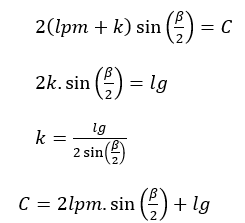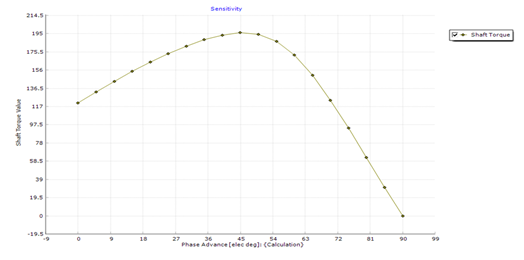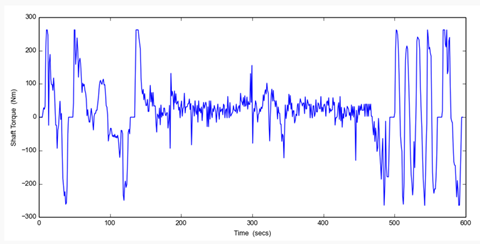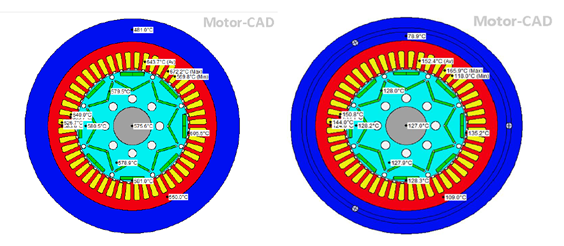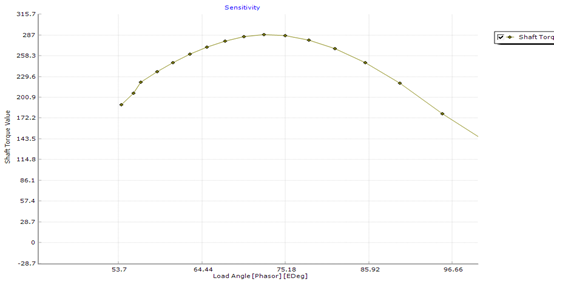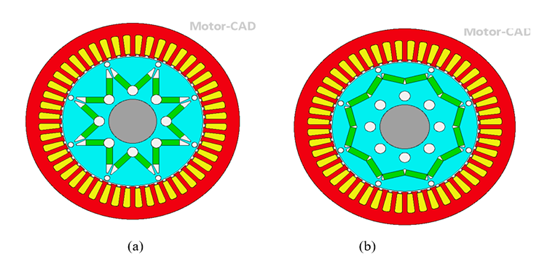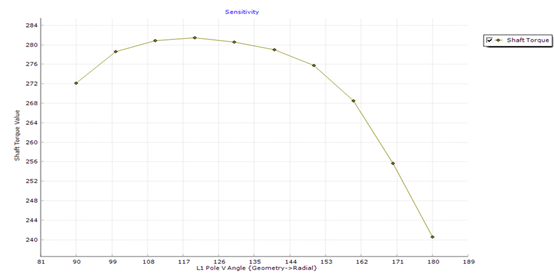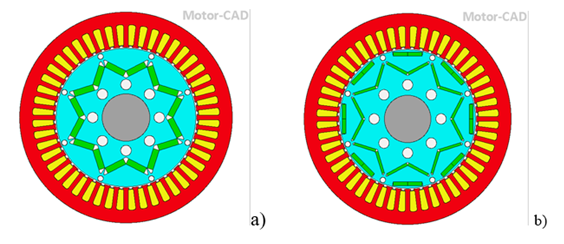The V-Angle and Rotor Ducts Influence on the Variable Reluctance Permanent Magnet Synchronous Machine on the Output Torque
- Godfrey Murairidzi Gotora
- Godfrey B Zulu
- Tadiwa B Taderera
- 407-413
- Jul 15, 2024
- Electrical Engineering +1 more
The V-Angle and Rotor Ducts in Fluence on the Variable Reluctance Permanent Magnet Synchronous Machine on the Output Torque
Godfrey Murairidzi Gotora, Godfrey B Zulu, Tadiwa B Taderera
Department of Electrical and Electronics, University of Zimbabwe, Harare, Zimbabwe
DOI: https://doi.org/10.51584/IJRIAS.2024.906036
Received: 23 May 2024; Revised: 05 June 2024; Accepted: 11 June 2024; Published: 15 July 2024
ABSTRACT
Permanent magnet synchronous motors have risen to be a favour able choice for use in electric vehicles due to their high torque output and efficiency [9], whilst also being relatively lightweight in comparison to their asynchronous counterparts. It is of interest to investigate the parameters of the motor that can be optimized to further improve their efficiency, and in this paper, an analysis of the influence of altering the V angle and rotor ducts on the shaft torque which in turn influences the efficiency will be conducted. Though maximizing efficiency and shaft torque is the major focus of this study, it should be noted that other factors such as weight, cost and thermoregulation impact the choices made to apply the parameters used on the final product, but these findings aim to show how torque and efficiency can be maximized through running such simulations.
Keywords: Synchronous motor, rotor ducts, permanent magnets, variable reluctance double, pole. V-angle.
INTRODUCTION
With global temperatures increasing by more than 1 degree Celsius since 1880, there’s been growing concern at the continued use of fossil fuels and efforts are being made to transition to green energy. Transport is a major contributing factor to global warming and when the idea of using electric vehicles rose, it was welcomed with much aplomb and most car manufacturers now have an EV line, and certain governments have put special grants and discounts on the purchase of EVs to encourage people to transition to more environmentally friendly transport. Inside electric vehicles, a system of battery packs, converters and motors are used as the power train. One of the major constraints of EVs has been the considerable weight of the batteries required and the limited driving range in between charges, therefore it is of much interest to investigate ways of getting as much out of the power-train as possible, so that the car can perform more efficiently, and in turn drive longer. The motor studied in this paper is the (PMSM) permanent magnet synchronous machine. A more recent model would have been preferable, but one of the major drawbacks was finding specifications for current models as they are heavily patented and protected by their owners. Regardless, this study effectively underlines some of the key parameters that can be altered in motors of this kind to ensure maximum shaft torque, and further studies can be suggested on also improving battery technology used [3].
In general, synchronous machines are divided into two umbrella categories based on their magnetic flux excitation mode of their respective rotors namely the salient rotor and cylindrical pole. This type of machine, the variable reluctance permanent magnet synchronous motor comprises of permanent magnets embedded inside the rotor it is for this reason they are termed permanent magnet variable reluctance synchronous motor [1]. It has been of great interest within recent years on electric cars, due to its massive output power. Due to its multi-phase nature of its dimensions. It happens that there are different methods of modelling it based on its numerical equation and its performances of course both employing the finite elements methods of resolving because of its geometrical complexity of the synchronous machine and also taking into account the non-linearity of the materials that it is fabricated from.[3]
RESULTS AND DISCUSSION
After the simulations, the graphical outputs of torque, electromotive force as well as speed has been noted, though the focus was on the output torque part. In the script the influence of the inclination of the permanent magnets and the number of permanent magnet layers has been analyzed on the dynamic performance of the torque of motor.
METHODOLOGY
For the most part of this study, the simulations were conducted using ANSYS Motor-CAD, an application that allows for the accurate representation of different motor types and perform electromagnetic, thermal and drive cycle calculations using the finite element analysis method[6].This computer aided application is of great significance in the context that it can do motor simulations with the ability to study or analyse even up to the smallest aspect unlike other soft-wares where its difficult to analyse one particular component on its own So the first step is to put all the parameters that are to be studied. Simulate it and find the geometrical structure of the desired permanent magnet synchronous machine. Then after to start to study and analyse only one particular component [5].
The key parameters of the motor to be analyzed are shown in the following table:
Table 1: Nissan LEAF motor parameters
| Parameter | Symbol | Value | Units |
| Nominal Power | PN | 80 | KW |
| Nominal Voltage | UN | 345 | V |
| Nominal Torque | CN | 280 | N.m |
| Nominal rotation speed | NN | 10 390 | Tr/min |
| Number of poles | 2.p | 8 | |
| Number of phases | m | 3 | |
| Connection | – | Y | |
| Isolation Classe | – | H | |
| Weight | M | 58 | kg |
1.5.a The influence of the phase angle on the torque.
Different angles has been analyzed and observed the variation of the shaft torque of the variable reluctance synchronous motor and a graph has been drawn showing the pattern. As portrayed by the graph below its evident that the greatest shaft torque is at the angle of 45° on the rotor permanent magnet.
The equations below shows the different geometrical parameters of the used to calculate the V-angle of the machine.
After resolution of these equations we come to the conclusion that
where β is the V-angle
Lg: inner length between two edges of the permanent magnets.
Lpm: permanent magnet lengths
C: inner length between two permanent magnet edges in a V-shape.
Fig 1: the graph showing the variation of the shaft torque to the phase angle
1.5.b The influence of rotor ducts on shaft torque
The rotor ducts present in the motor serve as canals for the cooling fluid used for thermo regulation. However, an investigation of the influence of the presence of rotor ducts on shaft torque is undertaken to measure if its thermo regulatory effect outweigh its bearing on shaft torque. Using the Lab mode on Motor CAD, a load test of the motor is undertaken using the US06 drive cycle and the following graph was obtained of the motor functioning with and without rotor ducts
Fig2. Shaft torque during the US06 drive cycle of the motor without rotor ducts
Fig3. Shaft torque during the US06 drive cycle of the motor with rotor ducts
As seen from the graphs, there is a marked increase in shaft torque in the absence of rotor ducts. This can be attributed with the increased amount of the ferromagnetic material in the rotor core, which results in increased flux lines and therefore a higher shaft torque produced. This study would be incomplete without analyzing the effect on thermo regulation upon the removal of the rotor ducts. The image below shows a comparison of the thermal charts of the two cases compared.
Fig 4: Thermal chart of the motor a) without rotor ducts and b) with rotor ducts
From the above diagram, one notes the excessive temperatures recorded throughout the different materials used in the motor when the rotor ducts are removed, temperatures beyond the operating limits of the motor, such that it’ll massively impact the motor’s lifespan.
1.5.c The load angle and rotor ducts presence on the variable reluctance permanent magnet synchronous machine.
From the simulation the rotor ducts has a significance on output torque [8]. Hence-after we observe the variation of the load angle in respect to shaft torque. The rotor ducts improves the magnetic flux created in the rotor. However the electromotive force produced is proportional to the speed, so by increasing the speed it also means the acceleration is improved which is the reason why the variable reluctance permanent magnet synchronous machine is preferred in electric cars nowadays.
Fig 5: showing the variation of the load angle with respect to the shaft torque.
1.5.d The influence of the pole V-angle to the shaft torque
Radial geometrical presentation of the motor with an pole V-angle of 90° and V=150°.
Fig 6: the curve above shows the variation of the V-angle with respect to shaft torque
1.5.e The influence of the layers of the permanent magnet on the machine.
It has been analyzed the two different scenarios, one with a single layer of the permanent magnet and the other one with a double but maintaining the global weight of the rotor constant. The two cases gave the outcomes below.
The radial representation of the motor a) single layer permanent magnet b) double layer permanent magnet.
Table 3
| Single layer permanent magnet motor | Double layer permanent magnets motor | |
| Maximum torque N. m | 207.17 | 305.55 |
| Average torque N. m | 197.19 | 288.41 |
| Shaft torque N. m | 195.88 | 287.05 |
| Power factor | 0.562 | 0.82 |
| Efficiency % | 93.062 | 95.211 |
CONCLUSION
Even though the perfect motor for all cases doesn’t exist but however, each motor has its own advantages and inconveniences depending on the usage [12]. But however the geometrical topology of the rotor ducts and permanent magnets has a great contribution to the output torque especially taken at the best angle of inclination. In addition to that some factors do contribute to the final torque of the synchronous motor taken for example the the environmental conditions where the machine is subjected. As per the known records the efficiency of electric motors is of great significance especially in the industrial and transport sector, on that regard if one needs to put into effect permanent magnet synchronous motors has to be aware of the performance to it.
REFERENCES
- Thomas A. Lipo; Yuefeng Liao, both of Madison, Wis. <<variable reluctance motors with permanent magnet excitation>>, Article,1992
- Klempner., G., Kerszenbaum I., <<Operation and maintenance of large turbo-generators>>. Edition John wiley & sons inc. 2004.
- Chunting, M., <<modelling of iron losses of permanent magnet synchronous motors>>, Thèse de doctorat, Université de Torronto, 2001.
- Chen., X., <<Modelling and design of permanent-magnet machines for electric vehicle traction>>. Thèse de doctorat, Université de Sheffield, 2015.
- Iqbal, A., Moinoddin, S., Reddy, P., <<electrical machine fundamentals with numerical simulation using matlab/simulink>>. Edition John wiley & sons inc,
- Pyrhonen, J., Jokinen, T., Hrabovcov, V., <<design of rotating electrical machines>>. Edition John wiley & sons inc. 2008.
- Kaddour, H., <<etude de la machine synchrone autopilotée : modélisation et simulation.>> Mémoire de master. Université d’ Oran. 2012.
- Farshadnia, M. <<Advanced theory of fractional-slot concentrated-wound permanent magnet synchronous machines>> 2018
- Powell, D., <<electric car statistics-data and projections>>, heycar.co.uk.2020.
- Xue, S., Chu, W. Q., Zhu, Z. Q., Peng, J., Guo, S., & Feng, J. (2016). Iron loss calculation considering temperature influence in non‐oriented steel laminations. IET Science, Measurement & Technology, 10(8), 846-854.
- Ujjwala T, Vishwesh A.<<Fractional-Order PI controller for permanent magnet synchronous motor: A Design-Based Comparative Study>>. 2018.
- Wonho J, Sung-Hyun, Yoon-Seop L, Sungjin C, Yong-Hwa P<< Vibration and current dataset of three-phase permanent magnet synchronous motors with stator faults>>article 2023.

